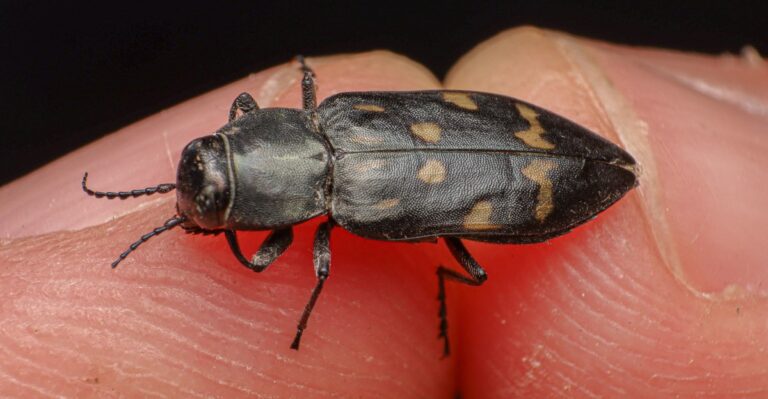A late-summer heatwave has ignited a wave of devastating wildfires across the western United States, forcing thousands to evacuate and casting the sky in an eerie orange hue in parts of Southern California.
Of course, this is bad for almost everyone, except for the melanophila beetles.
These pumpkin seed-sized insects are pyrophiles, meaning they love fire and need it to reproduce: While most animals are fleeing wildfires, these insects fly toward the flames, where they mate and lay their eggs in the embers.
Those eggs hatch into insect-like larvae that feed on the freshly burned wood.

The Rhine Fire in Running Springs, California, on September 7.David McNew/Getty Images
A fire-breathing orgy may sound like a terrible idea, but it has a lot of benefits for these insects: When forests are engulfed in flames, there are fewer insect-eating predators available, which may be one reason the behavior evolved, scientists say.
As cars and power plants continue to warm the planet, wildfire seasons will likely get longer and more severe. Animal adaptations like these offer some useful perspective: They serve as a reminder that climate change won’t just spell a dead end for all life. Some species just love the heat.
How Firebugs Find Fire
Although these beetles are not particularly striking in appearance, their anatomy is impressive. Similar to home security systems or night vision goggles, their bodies are equipped with infrared sensors. These sensors, called sensory pit organs, detect infrared light, which is an indicator of heat. These pits, located on the underside of the insect’s body, help direct the insect to the direction of fire.

Black fire beetle, Melanophila acuminata.
Kuvama/iNaturalist
Using sensors in their antennae, these beetles may also be able to detect smoke: During football games at the University of California, Berkeley, in the 1940s, smoke fumes from fans lit cigarettes regularly attracted hordes of Melanophila beetles, angering the fans, author James Agee writes in his book. Fire ecology of Pacific Northwest forestsCigarettes don’t produce much heat, so researchers suspect that the smoke may have attracted them.
Using these sensory systems, firebugs are able to detect flames from far away; one model-based study from 2012 suggested that these firebugs can “see” a large blaze from roughly 80 miles away, about the distance between New York City and Philadelphia. So where there’s fire, there are often firebugs.
Firefighters know this fact well.
“Wildfire firefighters hate these beetles,” Lynn Kimsey, an entomologist and director of the Bohart Museum of Entomology at the University of California, Davis, told me last year. “Especially if you’re fighting a fire around a burning tree, the beetles will come in in droves and get in your line of fire and bite you.”
The sting feels similar to that of a bee, so firefighters sometimes wear bee veils for protection.
Why do these beetles seek scorched earth?
When male beetles arrive at a forest fire, they have only one thing on their mind: sex. The insects often land on trees “near burning, red-hot, or hot ashes,” researchers explain, and when they find a female, they “attempt to mate vigorously (literally in the heat of the moment).” The female then lays her eggs under the bark of the burnt tree.
Why choose a freshly burned forest?
The simplest explanation is that their offspring, the beetle larvae, can only survive on burned wood. When a tree is scorched by fire, its defense systems are weakened or nonexistent, allowing the beetles to easily penetrate the wood beneath the bark. “They can get in there and feed freely,” Kimsey says.

A carbonized beetle seen near San Diego, California.
Pavel Bikau/iNaturalist
Plus, many insects tend to avoid recently burned areas, so when fire beetle larvae emerge, they have less competition for food and can hone the wooden buffet to themselves. These areas also typically have fewer insect predators, such as birds. (Though in a surprising example of evolution, some species, such as the spotted woodpecker, have evolved to feed on the larvae of fire-associated insects.)
Another reason they follow fires is that beetle larvae may develop faster in freshly burned areas: Some evidence suggests that heat speeds up development, almost like a warm incubator, meaning the beetles can produce more larvae in a shorter period of time.
A rare climate change winner?
Rising temperatures linked to climate change are already causing problems for many ecosystems and species: They’re causing heat waves and hurricanes that kill coral, shrinking some animals and making others sleepless, and making large parts of the Earth unfriendly to life.
At least in the short term, fire beetles (and some other beetle pests) may be able to buck these negative trends: Climate change is making wildfires more widespread and intense, and scientists believe fire beetles can only thrive on fire.
Kimsey said for now this is just speculation. “We have no idea what they’re doing when there’s no fire,” she said.
What’s clear is that climate change will create winners as well as losers, and this beetle species may be one of them. A burning world may become a world filled with horny beetles.


